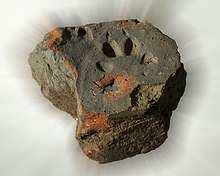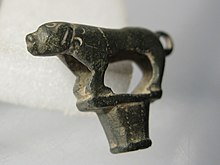User:Sarahr26/Dogs of Roman Britain
Dogs of Roman Britain concerns the presence of dogs within Britain under Roman occupation. Through various excavations in the Province of Britannia, evidence for a variety of uses from dogs has been found. There has been presences of dog remains, figurines of dogs, and use of dogs in religion found among the remains of excavated sites. Along with this are written references to the use of dogs as well.
Cultural Significance[edit]
Dogs are often portrayed in religion with the gods or goddess they are attributed to.
Despite worship for the goddess Nehalennia extending farther than the English Channel, the imagery of the deity with a lap-dog alongside her is frequently associated with the protection of merchants sailing from the Rhine and Mosel to Britain.[1] This dog has been described by a variety of sources as anything from a Roman greyhound, a Yorkshire terrier, or a Welsh Springer Spaniel.[2] [1] The latter is theorized by some to be the origin of the historical "Agassian". [3]
Likewise, Sucellus is also pictured with a dog. However, in this instance, it represents a connection with the underworld.[4]
Other cultural practices associated with dogs are funerary practices. As dogs were seen to have a connection to the underworld, placing figurines of dogs with the dead was thought to help souls with passage.[5]
Dogs were also connected to health as they were thought to have healing powers. The Romans thought dogs were only susceptible to gout, distemper, or rabies, and so puppies were often used as a sponge to transfer the pain.[6]
"Pets"[edit]

Through zooarchaeological research, evidence has been found that supports the idea that domestic dog ownership was prevalent in Roman Britain.[7] Human care for dogs can be seen in the analysis of the bones left behind.
Canine burials have few credible instances in Roman Britain, and it difficult to measure the relation the colony's inhabitants had with domestic dogs for this reason. Within the remains of one site in La Bourse, Marseille (France)[8], it can be deduced that the recovered dog had significant dental issues that were sustained for a while. Evidence such as the loss of its maxillary teeth and the unusual amount of calculus buildup proves that this dog would have needed human care in order to eat. With this knowledge alongside the apparent abundance of the animals in Roman British life, it is likely that such dogs were treated equally in this regard. [9]
However, terminology such as the word "pet" is problematic in the context of Rome as work animals and pets were often the same thing in antiquity. Using the word pet also subconsciously projects modern interpretations of what a pet is onto the ancient world. Therefore, it is MacKinnon's suggestion that "personal animal" is a more reflective term for the role of dogs in Roman Britain.[10]
Hunting[edit]
British hunting dogs, despite their role as herding and guard animals, were widely considered to be physically superior to the militarized Molossus of Epirus.[11] In the direct description of what some presume to be a predecessor to the English Mastiff breed, Strabo describes British hunting dogs as notably clever.[12] In other writing, he references hunting dogs being a primary export of British trade as a result of this high quality.[12]
Economic Contributions[edit]
Roman Britain was lacking in the resources other colonies provided, and the superior domestic dog breeds found in the Isles were consequently a prominent export and source of trade.[13] Of the British breeds, the most popular from Roman written record included the Irish wolfhound, the English Mastiff (then referred to as pugnaces), and the Agassian. Aside from companion-based uses, dog products such as meat and hide were also known attributes of the Roman Britain economy.[14]
Depictions in Art[edit]

The relationship between Britain and the production of hunting breeds was significant enough to render the image of hunting with domestic dogs often synonymous with the territory itself in Roman art.
Figurines were found in an excavation at Southbroom which consisted of dog-like creatures.[15] Some of them depicted a long protruding tongue while others have a limp human in their jaws. It is suggested that these differences in the figures indicate a transition from a predator to a domesticated animal.[5] However, another important factor to note is that the dog figurines found in this hoard always depict the dog larger than the human. This may be a representation of a deity or divine depiction of the dogs as protectors. This idea can be seen as a visual display of dogs being associated with the underworld. [16]
References[edit]
- ^ a b Piercy Fox, Nancy (1967). "The Ritual Shaft at Warbank, Keston | Kent Archaeological Society". kentarchaeology.org.uk. p. 188. Retrieved 2021-03-02.
{{cite web}}: CS1 maint: url-status (link) - ^ Davidson,, Hilda Ellis, (1998). Roles of the northern goddess. Routledge. p. 112. ISBN 0-415-13610-5. OCLC 481184189.
{{cite book}}: CS1 maint: extra punctuation (link) CS1 maint: multiple names: authors list (link) - ^ "Welsh Springer Spaniel Dog Breed Information". American Kennel Club. Retrieved 2021-04-13.
- ^ DURHAM, EMMA (2014). "Style and Substance: Some Metal Figurines from South-West Britain". Britannia. 45: 212. ISSN 0068-113X.
- ^ a b DURHAM, EMMA (2014). "Style and Substance: Some Metal Figurines from South-West Britain". Britannia. 45: 210. ISSN 0068-113X.
- ^ Snyder, L. (2016). Dogs and people in social, working, economic or symbolic interaction. Oxbow Books. pp. 62–64. ISBN 978-1-78570-426-0. OCLC 999474337.
- ^ MacKinnon, Michael (2010-06-01). "'Sick as a dog': zooarchaeological evidence for pet dog health and welfare in the Roman world". World Archaeology. 42 (2): 291. doi:10.1080/00438241003673011. ISSN 0043-8243.
- ^ MacKinnon, Michael (2010-06-01). "'Sick as a dog': zooarchaeological evidence for pet dog health and welfare in the Roman world". World Archaeology. 42 (2): 299. doi:10.1080/00438241003673011. ISSN 0043-8243.
- ^ MacKinnon, Michael (2010). "'Sick as a dog': zooarchaeological evidence for pet dog health and welfare in the Roman world". World Archaeology. 42 (2): 302–303. doi:10.1080/00438241003673011. ISSN 0043-8243.
- ^ MacKinnon, Michael (2010). "'Sick as a dog': zooarchaeological evidence for pet dog health and welfare in the Roman world". World Archaeology. 42 (2): 293. doi:10.1080/00438241003673011. ISSN 0043-8243.
- ^ Wynn, M. B. (1886). The history of the mastiff, gathered from sculpture, pottery, carving, paintings, and engravings; also from various authors, with remarks on the same. Melton Mowbray [ Eng.?]: William Loxley. p. 38.
- ^ a b Wynn, M. B. (1886). The history of the mastiff, gathered from sculpture, pottery, carving, paintings, and engravings; also from various authors, with remarks on the same. Melton Mowbray [ Eng.?]: William Loxley. p. 40. doi:10.5962/bhl.title.26386.
- ^ Going, Chris; Boast, Robin (1994). "BRITAIN AND ROME: A LASTING AFFAIR?". Cambridge Anthropology. 17 (2): 105. ISSN 0305-7674.
- ^ Maltby, Mark (2014-08-04). Millett, Martin; Revell, Louise; Moore, Alison (eds.). The Exploitation of Animals in Roman Britain. Vol. 1. Oxford University Press. p. 11. doi:10.1093/oxfordhb/9780199697731.013.045.
- ^ DURHAM, EMMA (2014). "Style and Substance: Some Metal Figurines from South-West Britain". Britannia. 45: 207–208. ISSN 0068-113X.
- ^ DURHAM, EMMA (2014). "Style and Substance: Some Metal Figurines from South-West Britain". Britannia. 45: 210–211. ISSN 0068-113X.
